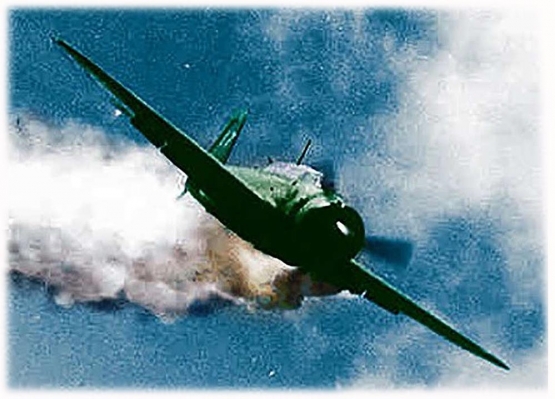World War Two - Kamikaze Attacks

"In a land where white is the color of mourning and black is the color of ceremony, where newspapers are read from right to left, this may have been a logical strategy. It was annunciated last week by the head of the Japanese government, Premiere Kantaro Suzuki... The upside-down Japanese mind could make the cost of conquest terribly expensive in American lives." A two page magazine article about the U.S. Navy destroyer Newcombe (DD-586), a hard-charging ship that suffered heavy damage from repeated Kamikaze attacks off of Okinawa on April 6, 1945 (the Ryukyu Islands):
"Then the plane shot past them, ripped through the gun mount and shattered itself against the after-stack. There was a blinding flash. The Newcombe shuddered and rolled heavily to starboard."
With the fall of imperial Japan, Yank correspondent Robert MacMillan was
one of the very first journalists to interview the Japanese Kamikaze pilot Norio Okamoto, which allowed his readers to gain some understanding as
to how the Kamikaze Corps operated:
"Okomoto's story took all the wind - the Divine Wind - out of the Kamikaze sails. Even the interpreter, a Japanese civilian, was surprised. He had worked for radio Tokyo and while he knew a lot of the propaganda stories were ridiculous, he had believed the Kamikaze legend."
Click here to read articles about post-war Japan. "American troops on Okinawa thought they knew all there was to know about Jap fanaticism. But last week the Japs served it up with a new twist. The evening of May 24 started out like any other on the battle-torn island. The enemy sent its usual flight of Kamikaze suicide planes to strafe American airfields and dive into shipping offshore... At the height of the earsplitting air battle, the Japs played their trump card" - from the fuselage of a twin-engine bomber that had belly-landed on an American airfield, emerged Japanese infantry. This unnamed journalist wished to discern fact from fiction as to what was expected from Kamikaze pilots. After spending almost an entire year in Occupied Tokyo, he read numerous reports on the topic, both military and civil. The PR blather fed to the Japanese public did state that a willing death was expected of them, but was surprised to find that many (not all) of the pilots were given parachutes (rarely used). His research revealed that the Kamikaze corps was hastily assembled and was composed of the lousiest pilots they could find. Admiral Marc Mitscher (1887 – 1947), U.S.N., remarked in the attached article that Kamikaze attacks may be a menace, but only ten percent of them manage to get through. |
MORE ARTICLES >>> PAGE: * 1 * 2 * |
|